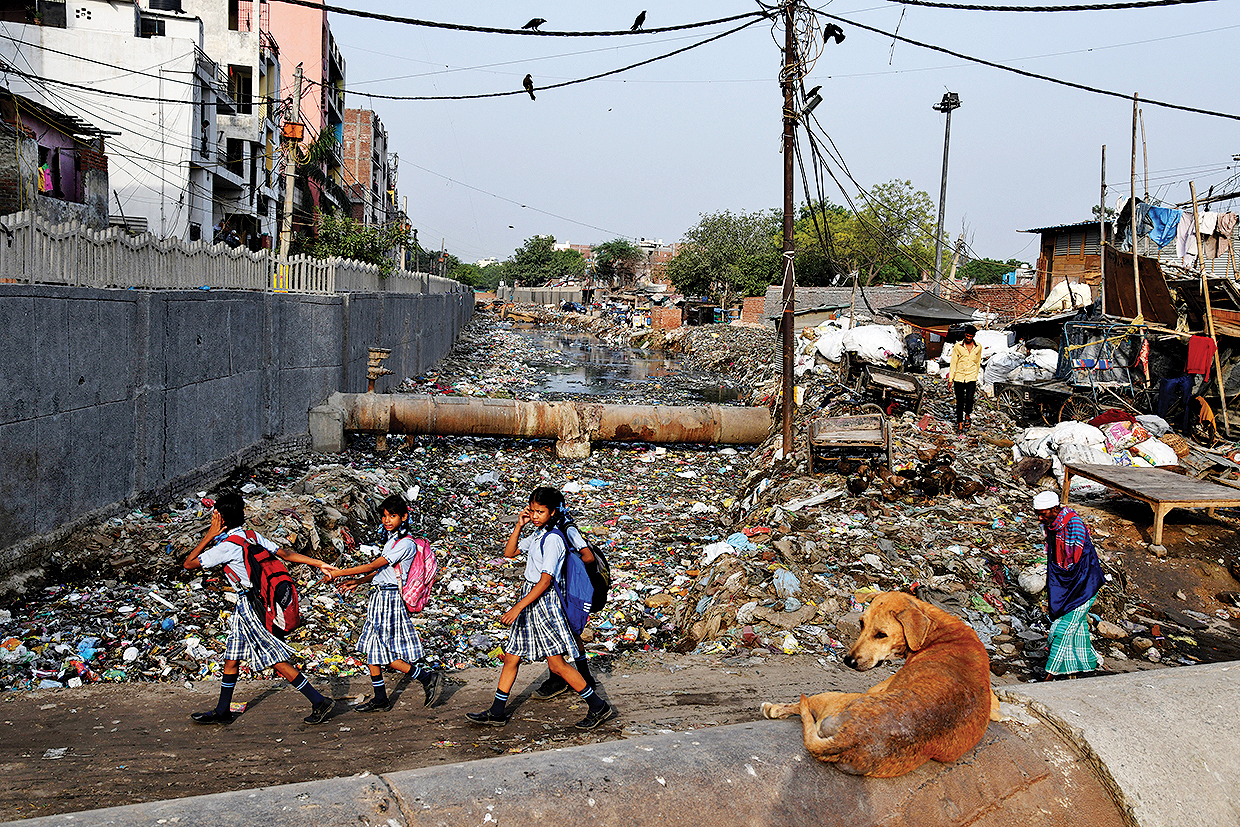Entrepreneur Tarun Bhalla found a unique way to protest against a half-a-kilometer long puddle of filth in front of his office that had not been cleared for seven long months. And struck pay dirt!
On March 2, on a small stretch of West Delhi’s Rama Road in Kirti Nagar, a huge ‘opening ceremony’ was organised. About 200 invitation cards had been sent out, among the invitees being MP Meenakshi Lekhi (BJP) and MLA Shiv Charan Goyal (AAP). Sweets were distributed at the ‘function’ and huge banners with the faces of Narendra Modi, Arvind Kejriwal and Rahul Gandhi were pasted on the walls.
The writing on the banners was not adulatory. It read “Tum mujhe vote do, hum tumhe kichad, dengue aur malaria denge!” (You vote for us, and we will give you mud, dengue and malaria in return!)
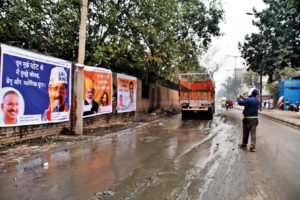
This was not the opening ceremony of some new project , but a ‘celebration’ of the inauguration of an ‘open air sewer lake’. All this was done at the initiative of Tarun Bhalla, an innovator and entrepreneur whose office is located right opposite the sewer lake. He is neither an activist, nor does he have any political agenda. He is just a disgruntled common man who decided to take action.
“For the past seven months, the road right opposite my office was brimming with sewage water and mud — ever since the rains. The sewage system was damaged, and water gushed out from a particular manhole. There was a foul stench in the air,” says Bhalla.
“It was a nightmare for all of us working here’” he adds. “We had approached the authorities with written complaints, including the MLA and MP, with no luck. No one was ready to listen,” says Bhalla. The area, which falls under the Najafgarh industrial belt, is home to a number of high-profile factories, offices and car showrooms and is surrounded by jhuggis.
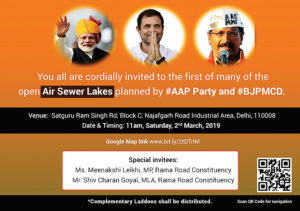
He says that recruitment at his company also took a hit due to this problem. “One man who was selected to work for our company outright rejected the proposal because of our surroundings,” he says. “In fact, there was a service centre of a reputed car company right beside our office which shut shop and moved to another location, because customers were complaining about the surroundings.”
The stretch of road where the sewage water stagnated is also home to small shacks of a tea seller and a roadside barber. “Our businesses were getting affected because of this filth,” says Ram, the roadside barber. “Customers stopped coming here because of the foul stench. My business took a hit for the past seven months. I even went to the MLA’s house, but I was turned away,” he says.
Bhalla felt their pain. “This was the last straw for me. I thought about the fate that these people had to suffer. I saw them setting up their shop in ankle deep filthy water and that is when I decided to do something.” However, he didn’t plan the elaborate ceremony right away.
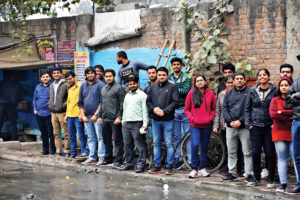
Bhalla’s first form of protest was a very simple step. “The people whose offices are in this area, stopped parking their cars on the waterlogged side of the road, ever since the drainage system got damaged. As a sign of protest I started parking my car on that side of the road, in the filthy water,” he says. “I used to wear gumboots to office. Every day, for the past few months, I got down in the water, crossed the road and came to the office,” he adds.
In the meantime, Bhalla used to take pictures and videos of the area and constantly post on his social media accounts, and also tagged the MLA and the MP in them. “We even approached them, but none of them responded,” says Bhalla. “We also approached the DDA, MCD and PWD, but none of them responded to us. It was then that I decided enough is enough, we need to do something drastic,” he adds.
What followed was one of the most unique forms of protests one could imagine. “I decided to make three large banners representing three parties — BJP, AAP and Congress — with the same slogan on all the three banners,” says Bhalla. While in the banner for AAP, a picture of area MLA Shiv Charan Goyal was printed alongside a huge picture of Arvind Kejriwal, the BJP poster contained a large image of the Prime Minister, along with the area MP Meenakshi Lekhi. The poster of the Congress had the party chief Rahul Gandhi along with Delhi Congress chairperson, Sheila Dixit.
“All these parties are the same. No matter which of them comes to power, they will never deliver what they promise. So, we targeted all three parties, even though the Congress is in no position of power in this area,” says Bhalla. The posters cost him Rs 2,100. Hespent it all from his pocket and did not take a penny even from his own company funds.
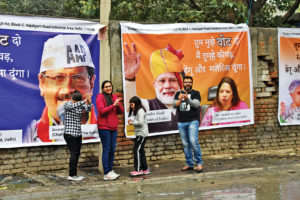
So, how did the idea of making these posters occur to him? “I saw a few banners in this area given by the AAP, which claimed that they had made a certain number of public toilets, thus improving the quality of hygiene in the area,” says Bhalla. “But here was the sewer lake that had not been cleaned for seven months, which made their statements completely false. That is when I decided to declare the true hygienic conditions of the area through big banners,” he adds.
In addition to these banners, Bhalla also printed 30 invitation cards and distributed them among people, including the legislators and even the executive engineer (South-west) of the PWD, whose office stands right next to the lake of filth. These cards even consisted of a QR code, which would give the exact location of the spot of the ‘sewer lake’ once it is scanned on a smartphone. “None of our high-profile guests showed up, though,” smirks Bhalla.
On March 2, the stage was set for the mega event. Bhalla had gathered his family and all of his colleagues on the road. A ribbon was tied for the 500 m sewer lake to be inaugurated. “My 11-year old daughter cut the ribbon and inaugurated it, as I wanted someone of her age to be involved too — so that she can realise the condition people live in,” says Bhalla, “She was hesitant to get into the mud at first, but I said “Keechad saaf karne ke liye toh kichad mein utarna padega na” (To clean filth, you have to get into the filth yourself).
Soon, a large crowd of passersby gathered, and started taking pictures and videos of the goings-on. Even the vehicles that were passing the area stopped to take a look at what was going on. Meanwhile Bhalla and his colleagues were distributing laddoos among everyone, to “celebrate the failure of the authorities to do their basic duties”, says Bhalla. They were also urging everyone to take photos and share it on their social media platforms, by tagging the authority figures.
And it didn’t take long for the authorities to respond. “I put up the posters on Saturday morning, and within half an hour the PWD officers came and surveyed the area. Soon after, trucks carrying sanitation workers and equipment came and they started clearing the area” says Bhalla. “The 500m stretch of road, which hadn’t been cleaned in six months, was now almost clean within hours. They removed all the water and accumulated the mud and kept it in a corner,” recollects Bhalla. By Monday, even the posters were cleared out.
Bhalla, a business graduate from an American university, left his lucrative career in the West to come home and “create something which India could be proud of”, and so he set up his own robotics manufacturing company.
So, after his nasty experiences here, does he plan to return back to the West? “No chance. I plan to serve my country in whatever way I can. The politicians aren’t doing their work. So it is upto citizens like us to remind them to do their job,” concludes Bhalla.
This is the capital, unplugged
There are many areas in and around Delhi-NCR need someone like Tarun Bhalla to draw the attention of the authorities.
Nizamuddin West
The area that houses historic monuments like the Nizamuddin Dargah and Humayun’s Tomb is also home to the large Barapullah canal that passes through the Nizamuddin West area has been a storehouse of filth and pollution. The area has a foul stench in the air, and residents complain of corrosion of their electrical appliances. Cases of mosquito-borne diseases like malaria and dengue are also found in huge numbers.
Defence Colony
One of the most posh areas of the city, South Delhi’s Defence Colony, is a living hell come monsoon. The covered drains and the garbage from nearby food stalls clog the surfaces of the drain, and the streets remain waterlogged. This has been the case for many years now and none of the authorities seem to take any action.
Sant Nagar (East of Kailash)
Tucked in a corner of the hustling Greater Kailash area, the residents of this small colony face a huge issue. Almost every other month, the roads are dug up for some wire work or another, and thus the roads are filled with potholes. As a result auto rickshaw and cab drivers are reluctant to enter the area. During monsoon these potholes also fill up, leaving most of the area waterlogged.
Mayur Vihar Phase III
This is the area where the Kondli Sewage Treatment plant is located. The gas released by this plant not only creates a foul smell in the air, but also damages the electrical appliances of the area. Many residents have also fallen victim to asthma and other breath-related diseases. In 2017, about 4,000 residents threatened to boycott the municipal elections. Almost two years on, the problem persists.
